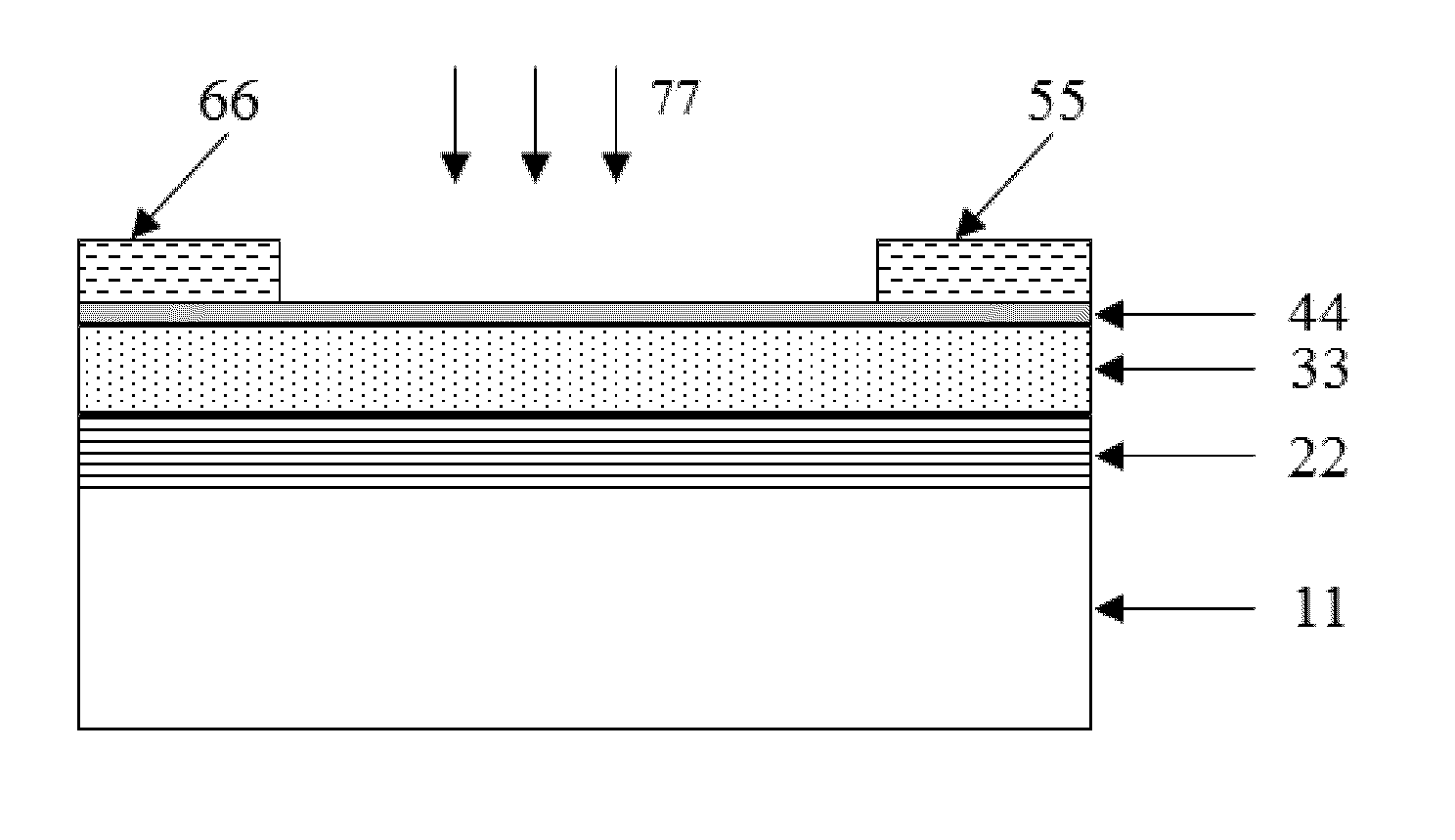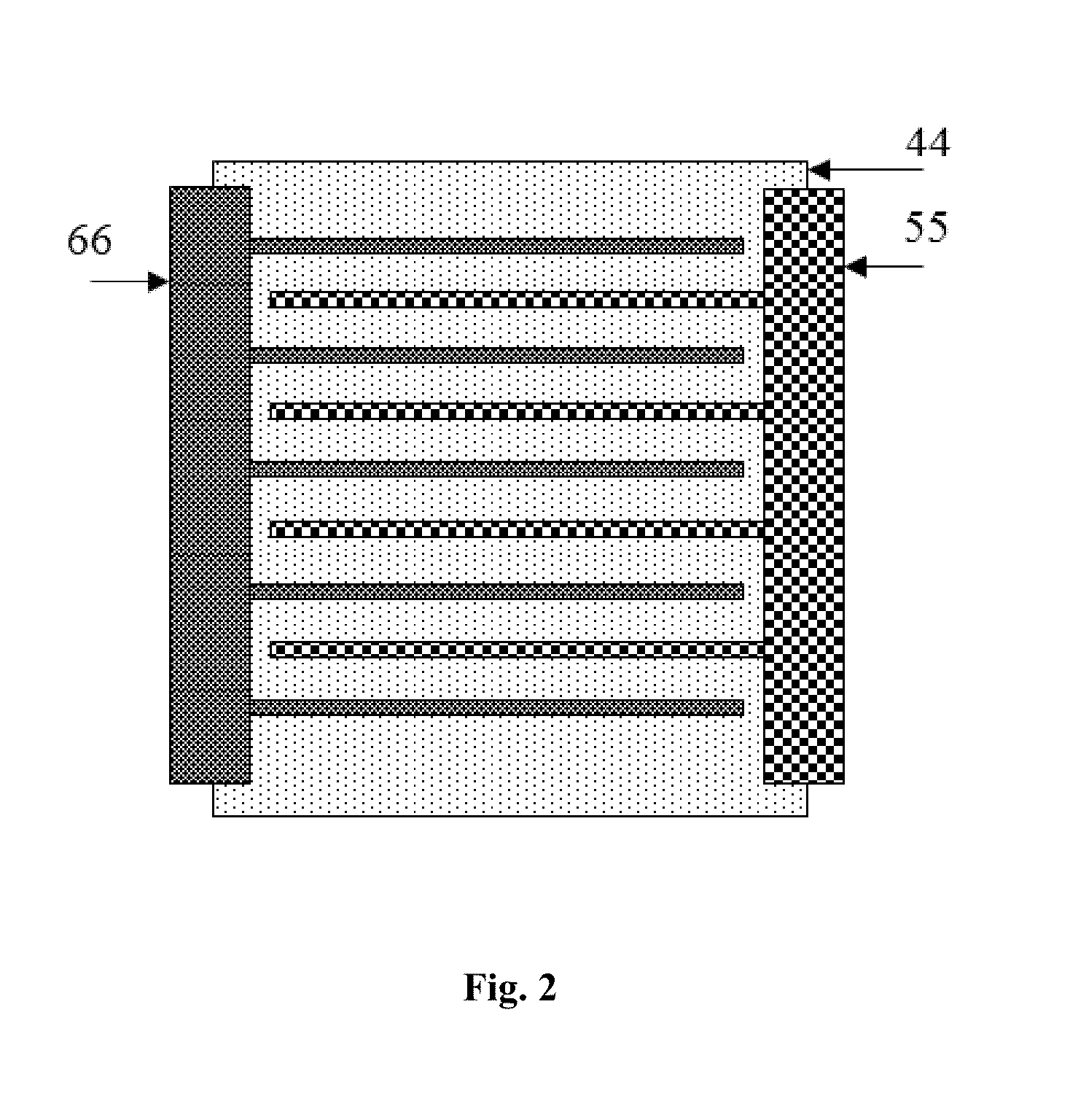Graphene transistor optical detector based on metamaterial structure and application thereof
a graphene transistor and optical detector technology, applied in the direction of radio frequency controlled devices, semiconductor devices, electrical apparatuses, etc., can solve the problem of less than 10 layers of graphene light absorption efficiency, which is far lower than the efficiency of other bulk materials or quantum well structures, and achieves improved detector sensitivity.
- Summary
- Abstract
- Description
- Claims
- Application Information
AI Technical Summary
Benefits of technology
Problems solved by technology
Method used
Image
Examples
embodiment 1
[0053]Referring to FIG. 1, a longitudinally sectional view of the graphene transistor optical detector based on a metamaterial structure provided in this embodiment is shown. The detector includes a substrate 11, a gate metal layer 22, a gate medium layer 33, a graphene layer 44 and a source 55 and drain 66 metal layer. In FIG. 1, the incident light is indicated by arrow 77. In this embodiment, the gate metal layer 22 forms a reflective layer of the metamaterial, and the source 55 and drain 66 metal layer forms a surface impedance matching layer of the metamaterial. By optimizing the gate medium layer 33 and a periodic structure of a source 55 and a drain 66, approximately complete absorption in a preset waveband may be obtained. Meanwhile, the gate metal layer 22 may be used as a gate of a transistor for regulating the band gap of the graphene layer 44 and forming a carrier conductive channel, thereby realizing photoelectrical conversion. In this embodiment, by integrating the grap...
embodiment 2
[0055]The longitudinally sectional view of this embodiment may refer to FIG. 1, and the top view thereof may refer to FIG. 3. A difference between this embodiment and Embodiment 1 mainly lies in that, the source 55 and the drain 66 in this embodiment form a two-dimensional structure, and the surface impedance matching layer of the resulting metamaterial may result in near-zero reflection to incident light in different polarization directions, so that the photoelectrical efficiency of the detector is further improved.
[0056]In this embodiment, the following specific materials and structures may be selected, wherein the gate material layer 22 is made of gold and has a thickness of at last 50 nm; the gate medium layer 33 is made of aluminum oxide (Al2O3) and has a thickness of 10 nm; the source 55 and the drain 66 are both made of gold and each have a thickness of 70 nm; and, the periodic micro / nanostructure formed by a partial structure of the source and drain metal layer has a side le...
embodiment 3
[0057]Referring to FIG. 4, a top view of graphene transistor optical detectors based on metamaterial structures during imaging application according to this embodiment is shown, where A, B, C and D denote graphene transistor detectors working in different preset wavebands, respectively, and the structure of each of these graphene transistor optical detectors may be any one of Embodiment 1 and Embodiment 2. By integrating the detectors A, B, C and D into a pixel I and periodically arranging this pixel to form a whole image sensor, multi-waveband imaging may be realized. For example, A and D are graphene transistor optical detectors working in blue and red wavebands while B and C are graphene transistor optical detectors working in a green waveband, then, an image sensor similar to a RGB (red, green, blue) color image sensor is formed. By optimizing various integration solutions of the graphene transistor detectors working in different wavebands, a multi-waveband super camera may be o...
PUM
 Login to View More
Login to View More Abstract
Description
Claims
Application Information
 Login to View More
Login to View More - R&D
- Intellectual Property
- Life Sciences
- Materials
- Tech Scout
- Unparalleled Data Quality
- Higher Quality Content
- 60% Fewer Hallucinations
Browse by: Latest US Patents, China's latest patents, Technical Efficacy Thesaurus, Application Domain, Technology Topic, Popular Technical Reports.
© 2025 PatSnap. All rights reserved.Legal|Privacy policy|Modern Slavery Act Transparency Statement|Sitemap|About US| Contact US: help@patsnap.com



